Your Trusted Guide to Aadhaar Services
Aadhar Card Download – Get Aadhaar, UIDAI (Unique Identification Authority of India)
The Aadhaar card is one of the most essential identification documents in India, which is only issued by the Government of India through the Unique Identification Authority of India (UIDAI).
Each of the card contains a unique 12-digit number that acts as a valid proof of both identity and address for Indian residents.
Click here to select or change your Preferred Language
Download e-Aadhaar
Download Aadhaar Card (e-Aadhaar)
Indian citizens can easily download their e-Aadhaar through four official and convenient methods. Here’s a quick step-by-step guide for each one of these methods.
Note: Under the Aadhaar Act, your e-Aadhaar is just as legally valid as the physical card — it can be used across all government and private services.
Method 1: Download from the UIDAI (MyAadhaar) Portal
- Visit website myaadhaar.uidai.gov.in
- Click on “Download Aadhaar”
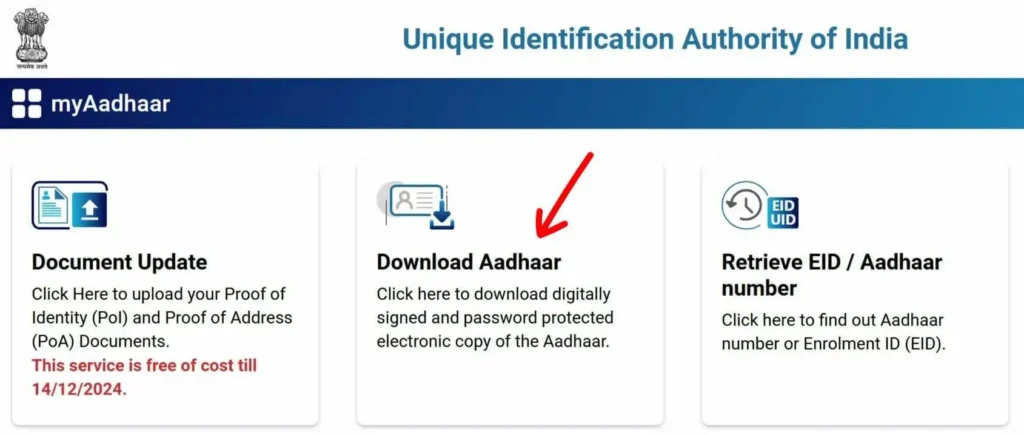
- Enter your Aadhaar number (12-digit), VID – Virtual ID (12-digit), or EID – Enrolment ID (12-digit)
Now You Know: The EID, or Enrolment ID, is a 28-digit number you get when you first apply for Aadhaar — it helps you track your application status. Once your Aadhaar is approved, you’re assigned a 12-digit UID, also known as your Aadhaar number, which acts as your official proof of identity and address.
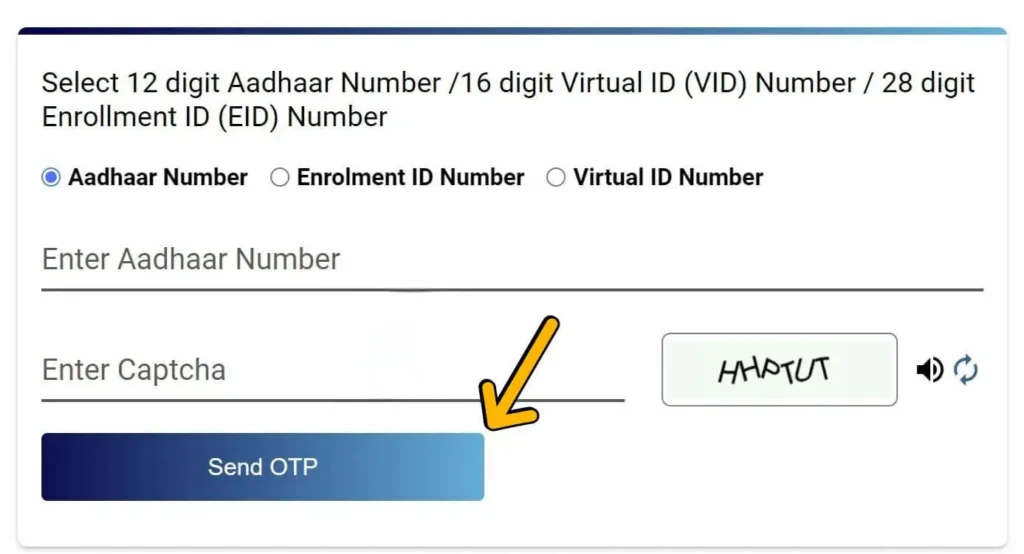
- Click “Send OTP” button.
- Enter the OTP once received on your mobile number
- Click “Verify and Download”
- Your Aadhaar card will now be downloaded to your mobile
Note: If your mobile number isn’t linked to your Aadhaar, you’ll need to visit your nearest Aadhaar enrollment or service center to get it added or updated.
Tip: Use the “Retrieve Aadhaar/EID” tool if you’ve forgotten your details.
Method 2: Download Aadhaar via DigiLocker
Downloading your Aadhaar through DigiLocker is a secure and paperless way to access your ID anytime, anywhere. It eliminates the need for carrying physical copies and ensures quick authentication at your fingertips.
Step 1: Log In to DigiLocker
- Go to the DigiLocker website or open the DigiLocker app on your Android or iOS device.
- Log in using your preferred credentials — this can be your mobile number, Aadhaar number, or username. You’ll then receive a one-time password (OTP) on your registered mobile number. Enter it to complete the login process.
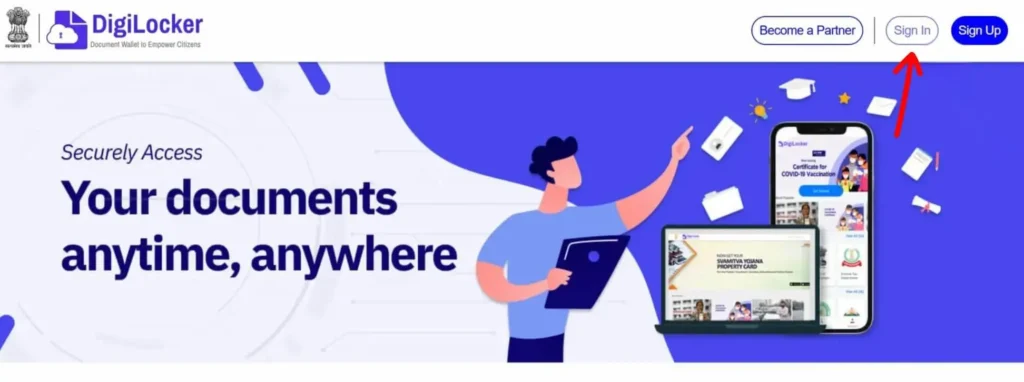
Note: If you haven’t signed up yet, you can create a DigiLocker account using your mobile number and email. The process is simple and takes just a couple of minutes.
Step 2: Search for Aadhaar Services
- Once you’re logged in, click on the “Search Document” option located in the main dashboard.
- Type “Aadhaar Card” into the search bar and select the correct Aadhaar option from the search results that appear.
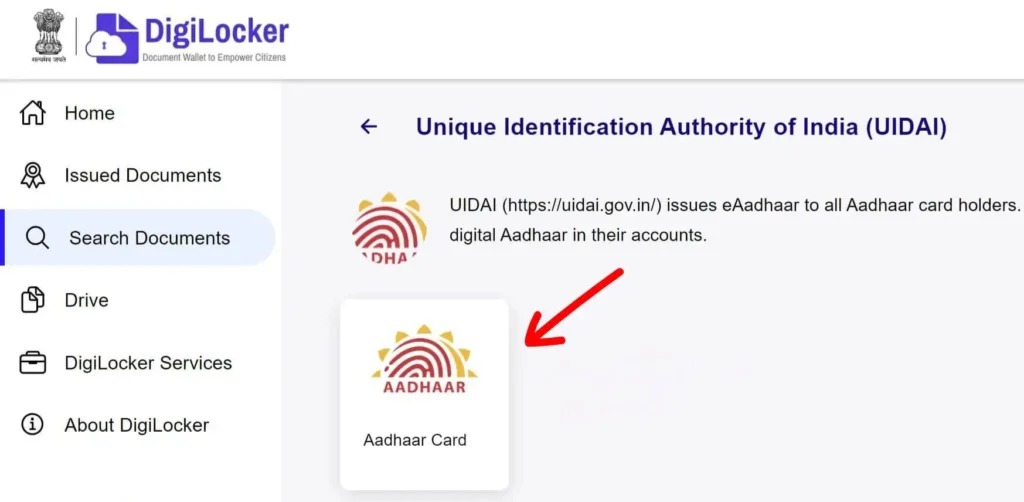
Step 3: Enter Your Aadhaar Details
- You’ll be asked to enter your 12-digit Aadhaar number. After entering it, an OTP will be sent to your registered mobile number for verification.
- Input the OTP to proceed.
Step 4: Retrieve Your Aadhaar
- Once your Aadhaar is successfully verified, DigiLocker will fetch your Aadhaar details directly from UIDAI’s official database.
- You’ll now find your Aadhaar card listed under the “Issued Documents” section in your DigiLocker account.
Step 5: Download Your Aadhaar Card
- To save a copy of your Aadhaar, go to the “Issued Documents” section.
- Click on the download icon next to your Aadhaar listing. If prompted, re-enter the OTP sent to your registered mobile number.
- Your e-Aadhaar will now be downloaded as a PDF file, ready for use anytime.
Method 3: Download Aadhaar via the mAadhaar Mobile App
The mAadhaar app, developed by UIDAI, offers a secure and convenient way to access your Aadhaar anytime from your smartphone. Follow these steps to download Aadhar using the app:
Step 1: Install the mAadhaar App
Start by downloading the official mAadhaar app from your app store.
- Available on both Android and iOS platforms
- Search for “mAadhaar” by UIDAI or use the links provided on the UIDAI website
Step 2: Open the App and Register
Launch the app and begin the registration process.
- Use your Aadhaar-linked mobile number
- Enter the OTP received to complete registration and set up your profile
Once verified, you’ll land on the main dashboard.
Step 3: Go to the Dashboard and Select ‘Download Aadhaar’
From the dashboard, locate and tap on the “Download Aadhaar” option.
This will take you to a new screen where you can proceed with the download process.
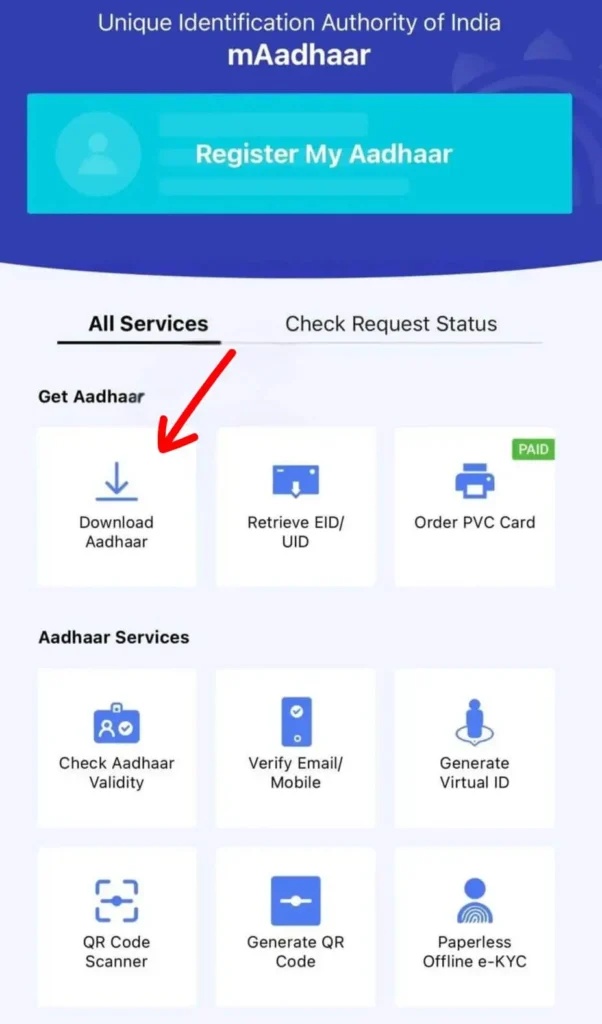
Step 4: Choose the Type of Aadhaar
You’ll be asked to select between two versions:
- Regular Aadhaar – displays your full 12-digit Aadhaar number
- Masked Aadhaar – hides the first 8 digits for privacy
Pick the one that suits your needs.
Step 5: Enter Required Information
Next, you’ll need to provide:
- Your Aadhaar Number, VID, or Enrolment ID
- Complete the captcha code displayed on the screen
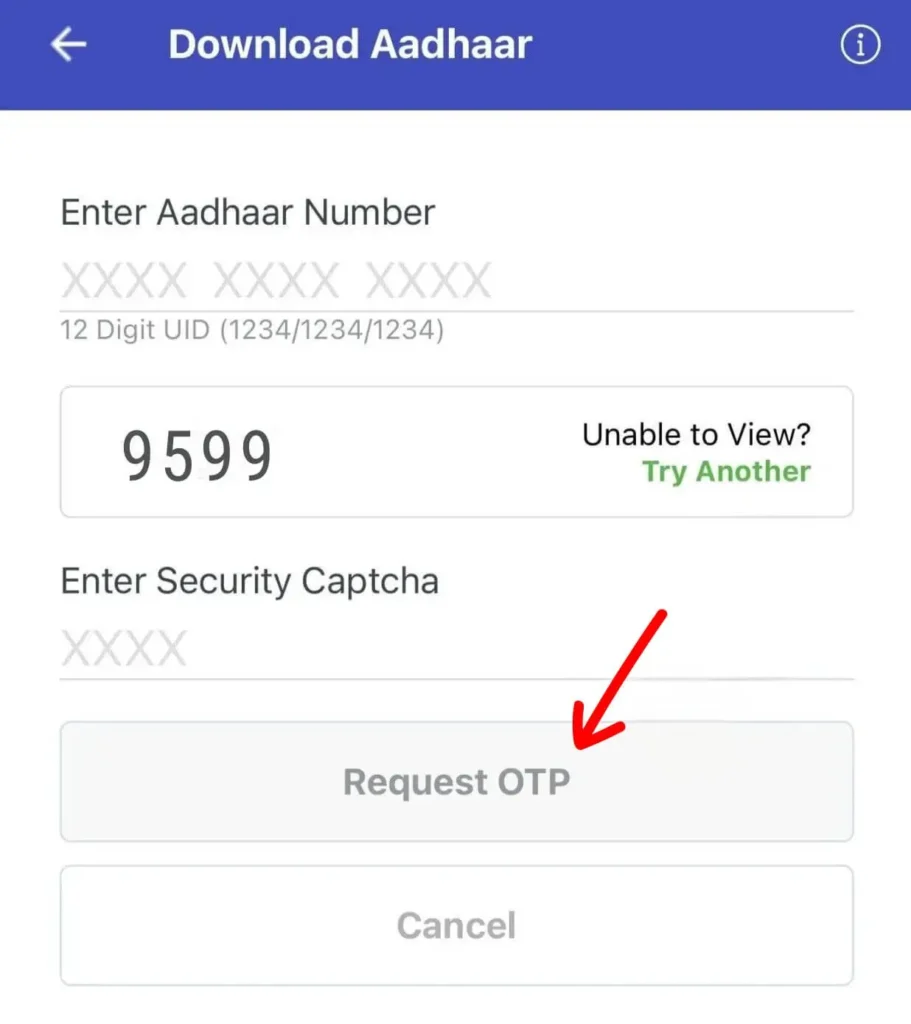
Step 6: Request and Enter OTP
Click on “Request OTP” and wait for the one-time password to arrive on your registered mobile number.
Enter the OTP in the given field to authenticate.
Step 7: Download Your Aadhaar Card
After successful verification, tap “Open” or “Download” to access your Aadhaar card in PDF format.
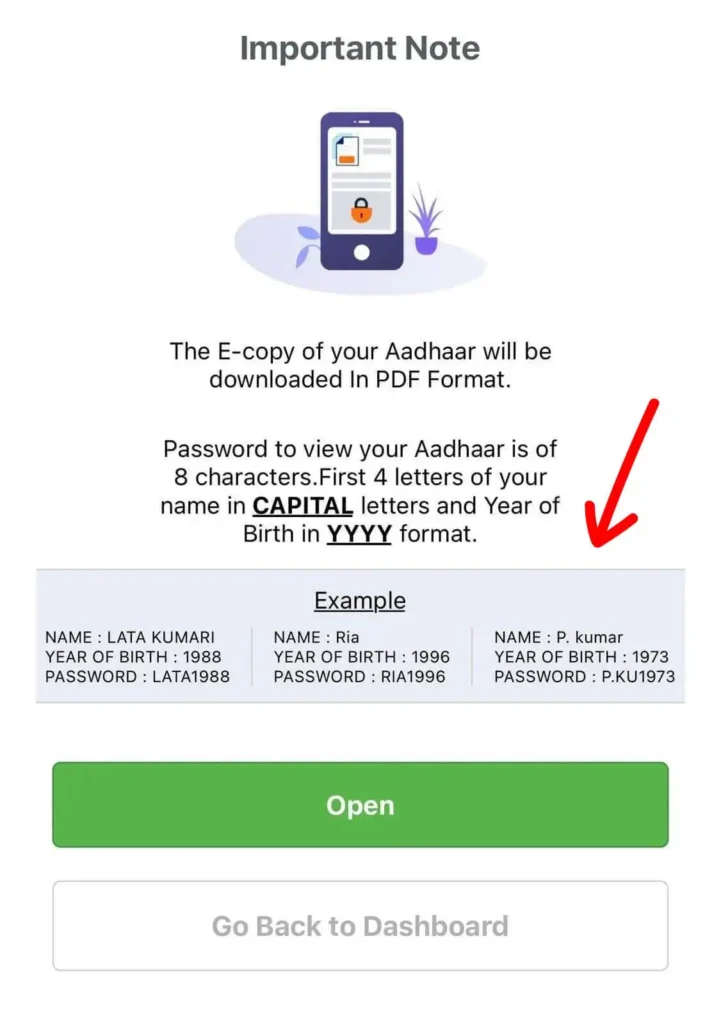
Important: The downloaded Aadhaar file is password-protected. To unlock it, enter the first 4 letters of your name in capital letters followed by your birth year (YYYY) — for example, RAJU1993.
mAadhaar App Features
The mAadhaar app is developed and maintained by UIDAI. It offers a secure and convenient way to store and manage your Aadhaar information digitally.
Key Features Include:
- Download e-Aadhaar
- Retrieve EID/VID
- Request a PVC Aadhaar card
- Verify your mobile number or email
- Generate a Virtual ID
- Track Aadhaar or PVC card status
- Check Aadhaar validity
Method 4: Download Aadhaar via UMANG Portal
If you’re an Aadhaar holder looking for a convenient way to access your e-Aadhaar, the UMANG (Unified Mobile Application for New-age Governance) portal offers a user-friendly and secure method to download it directly.
Step 1: Log In to the UMANG Portal
Open your browser and go to the official UMANG website.
- If this is your first time using UMANG:
- Register using your mobile number or email address.
- Set up a strong password for your account.
- Complete verification by entering the OTP sent to your registered contact.
- Already have an account?
- Simply log in using your mobile number, email ID, or username and your password.
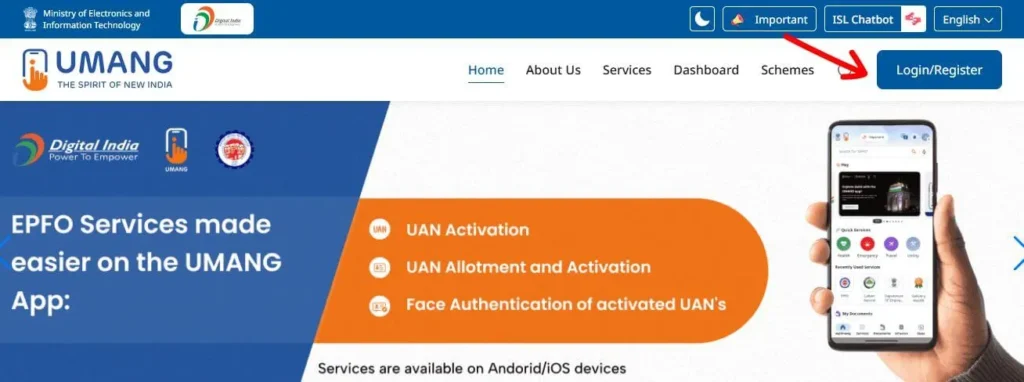
Step 2: Access Aadhaar Services
Once logged in, you’ll land on the UMANG dashboard with a variety of government services.
Scroll through the list or use the search bar to locate the “Aadhaar” section. Click on it to open Aadhaar-related services.
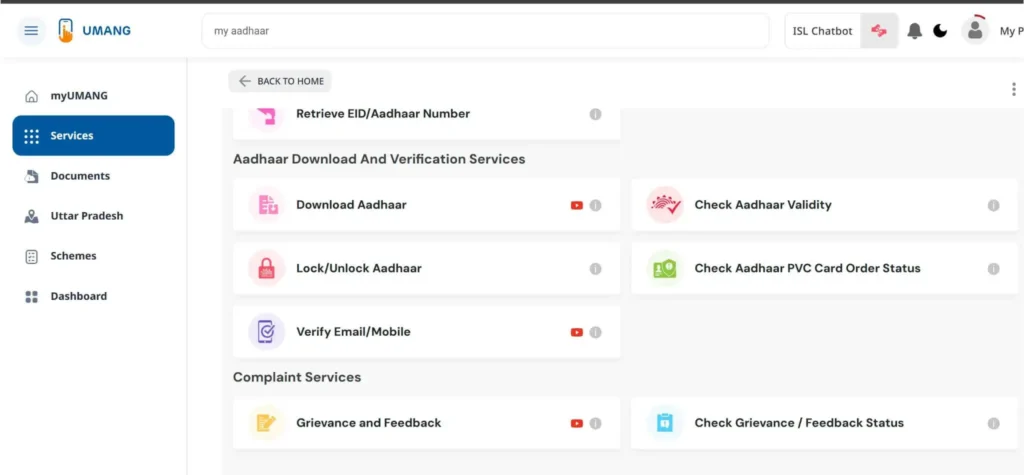
Step 3: Select the ‘Download Aadhaar’ Option
Inside the Aadhaar section, you’ll see a list of services like:
- Update Aadhaar
- Check Aadhaar Status
- Locate Enrolment Centers
- Download Aadhaar
Choose “Download Aadhaar” to move to the next step.
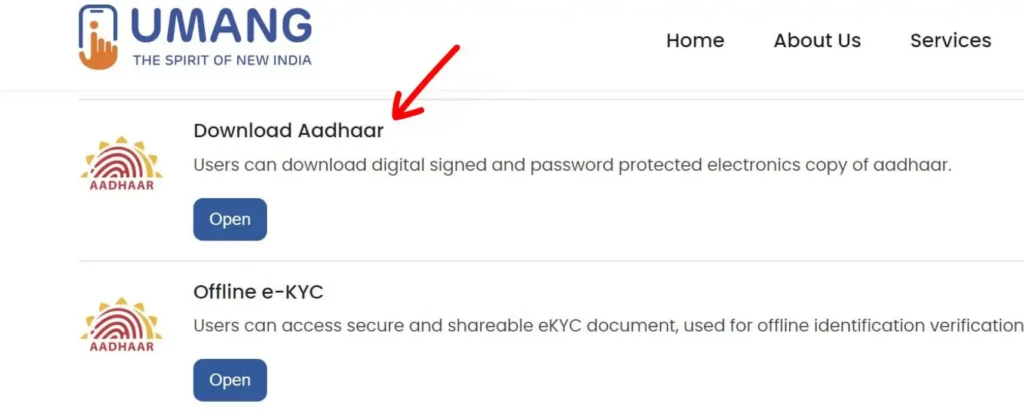
Step 4: Begin the Verification Process
Click the “Proceed” or similar button on the new screen to start your identity verification.
Step 5: Enter Your Aadhaar Number or VID
On the verification page:
- Enter your 12-digit Aadhaar number or VID (Virtual ID) carefully.
- An OTP will be sent to your registered mobile number.
Enter the OTP in the provided field to complete authentication.
Step 6: Download Your Aadhaar
After successful OTP verification, click the “Verify & Download” button.
Your e-Aadhaar will be downloaded automatically in PDF format to your device.
Important: The downloaded Aadhaar PDF is password-protected. You’ll need to use the password format:
First 4 letters of your name (in CAPS) + your birth year (YYYY)
Example: RAJU1992
How to Open Your e-Aadhaar PDF
Once you download your e-Aadhaar, you’ll notice that the file is password-protected. To open it, you’ll need to enter a specific combination based on your personal details.
PDF Password Format:
First 4 letters of your name in UPPERCASE (as printed on your Aadhaar)
+
Your year of birth in YYYY format
Examples:
| Name | Year of Birth | PDF Password |
|---|---|---|
| Neha Sharma | 1992 | NEHA1992 |
| Rakesh Singh | 1980 | RAKE1980 |
| Kavya Reddy | 1995 | KAVY1995 |
| Ankit Verma | 1988 | ANKI1988 |
| Meena Devi | 2001 | MEEN2001 |
Reminder: Your password is made by combining the first four letters of your name (as printed on Aadhaar, in UPPERCASE) and your birth year in YYYY format.
Note: If your name on Aadhaar is shorter than 4 letters, just use the full name in uppercase followed by your birth year.
Example: If your name is Ali, and you were born in 1993, your password will be ALI1993.
This password format helps protect your personal information while ensuring secure access to your Aadhaar file.
What is an Aadhaar Card?
The Aadhaar card is one of India’s most important and widely accepted identity documents. Issued by the Unique Identification Authority of India (UIDAI), it features a unique 12-digit number that’s assigned to every individual resident of India.
This number serves as a proof of identity and address, and is accepted across the country by both government and private institutions. Aadhaar plays a central role in everything from opening a bank account to accessing government welfare schemes.
What makes Aadhaar particularly powerful is that it’s backed by advanced technology — it allows for biometric verification (like fingerprints or iris scans) or OTP-based authentication using your registered mobile number.
Since its launch in 2009, Aadhaar has become the foundation of India’s digital identity system, with over 1.4 billion Aadhaar numbers issued to date.
What is e-Aadhaar?
e-Aadhaar is the digital version of your Aadhaar card — a secure, password-protected PDF file that contains all the same details as your physical Aadhaar, including:
- Your 12-digit Aadhaar number
- Full name
- Date of birth
- Gender
- Address
- QR code for verification
It’s issued directly by UIDAI and is digitally signed, making it just as valid as the printed Aadhaar card for most official purposes.
You can download your e-Aadhaar easily from the UIDAI portal, the mAadhaar app, DigiLocker, or UMANG. It’s especially helpful when you need quick access on the go or don’t have your physical card handy.
There’s also a Masked Aadhaar option, where the first 8 digits of your Aadhaar number are hidden for added privacy — perfect for situations where full Aadhaar details aren’t necessary.
In short, e-Aadhaar combines legal validity, convenience, and digital security into one portable document.
Uses of the Aadhaar Card
The Aadhaar card is more than just an ID — it’s a gateway to a wide range of services, benefits, and verifications. Here’s how Aadhaar is used across different sectors:
- Proof of Identity and Address
Aadhaar is widely accepted as a valid ID for government and private services, including hotels, telecom providers, banks, and more. - Access to Government Subsidies and Benefits
It’s linked to welfare schemes and used for Direct Benefit Transfers (DBT) like LPG subsidies, pension payments, and rural employment benefits. - Bank Account Verification (KYC)
Aadhaar simplifies Know Your Customer (KYC) procedures, making it faster and easier to open bank accounts. - Filing Income Tax Returns (ITR)
Linking Aadhaar with your PAN card is mandatory for filing income tax returns and availing certain tax benefits. - Getting a New SIM Card
Telecom providers use Aadhaar for instant electronic verification (eKYC), speeding up the process of activating mobile numbers. - Applying for Government Schemes
Aadhaar is often required when applying for schemes like Pradhan Mantri Awas Yojana (PMAY), Jan Dhan Yojana, and others. - Pension and Provident Fund Access
It helps authenticate pensioners and EPF/PPF claimants quickly and securely. - Digital Government Services
Aadhaar is used to log into various e-governance platforms and apps securely using biometric or OTP authentication. - Aadhaar-enabled Payment System (AePS)
Allows secure cash withdrawals and balance checks via biometric micro-ATMs, especially useful in rural areas. - Linking with Voter ID
Helps reduce duplicate entries in voter databases and ensures accurate electoral records.
Need Help with Your Aadhaar?
If you’re facing issues or have questions about your Aadhaar card, you can reach out using the following official channels:
- Helpline Number: 1947
- Email: help@uidai.gov.in
- Or visit your nearest Aadhaar enrollment or update center